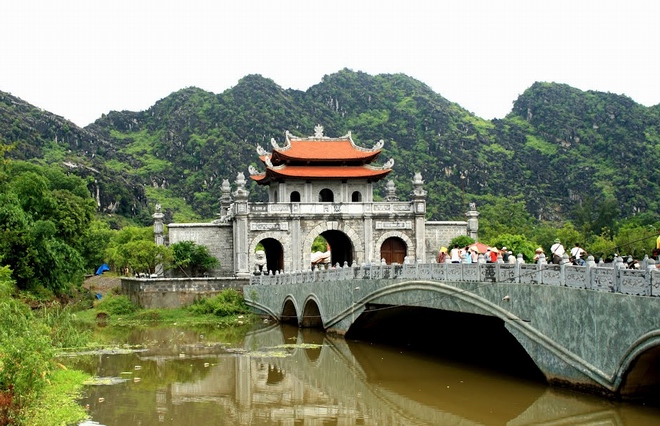|
Hoa Lu ancient capital was
the first of its kind in Truong Yen Commune, Hoa Lu
District, Ninh Binh. It is approximately 100km south of
Hanoi. In 968, Dinh Bo Linhs throne in Hoa Lo lasted
for 41 years, till 1009. The DInh Dynasty ruled for 12
years while the Le Dynasty ruled the next 29 years. For
hundreds of years, Hoa Lu was a thriving kingdom. The
mountains that surround the capital intertwine
beautifully with Hoang Long River and the Nho Quan, Gia Vien fields. The area also functioned as the perfect
line of defense for the revolutionaries, with its deep
trenches. Hoa Lu measures 300 hectares in width which
includes the inside and outside areas, and is also
surrounded by mountain ranges which create a magnificent
landscape.
The area outside the ancient capital measured 140
hectares widthwise, and belonged to Yen Thanh Village,
Truong Yen Commune. The palace of the Dinh Dynasty is in
the area. The Le Temple is at the center and the ancient
capital was also the same location where Dinh Tien Hoang
established the country. Before the palace was
constructed, Mount Ma Yen stood proudly on its
unfettered grounds. Chi Phong Village is found inside
the ancient capital. The village reared and trained
maids and children for the royal court. The Southern
area of the capital is flanked by soaring mountains and
rivers.
In 1010, Ly Thai To transferred the capital from Hoa Lu
to Thang Long. During the reign of Le Hoan, many
spectacular palaces were constructed such as Phong Luu
Palace, Bach Thao Thien Tue Palace, Cuc Lac Palace, Bong
Lai Palace, Truong Xuan Palace, Hoa Van Palace, and Long
Loc Palace which stands out because of its silver roof.
Time, rains, and sunshine for more than a decade led to
the slow deterioration of Hoa Lus ancient relics and
architecture. But the temple constructed by the Le and
Dinh Dynasty in the 17th century remains intact.
Dinh Temple was constructed behind the ancient palaces
and renowned places such as Ngo Mon, Mount Gia, flower
garden, and lotus lake. There is also a magnificent
monolithic stone called Long Sang near the temple.
There is a statue of Dinh Tien Hoang and his son inside
the temple. Many visitors come to worship the statue
because of the work done by Dinh to establish Vietnam as
a country. There are several carved images in stone and
wood which depict images of dragons, clouds, flowers,
and fairies. The carvings follow an intricate pattern.
Le Temple is approximately 500m from Dinh Temple. Le
Temple is small in size but has four sections which are
Bai Duong (where worship of Pham Cu Luong took place),
Le Dai Hanh, Le Ngoa Trieu, and Duong Van Nga. Le Temple
has retained its old vestiges of ancient design and
intricate decoration. Upon visiting, tourists will
discover the history behind the ancient ceramics and
palaces in the region. Most of the ancient relics are
kept on the left room inside the temple. There are also
well-known attractions inside the temple such as Nhat
Tru and Ngan Xuyen, which attracts several visitors
yearly. A visit to Hoa Lu will take tourists on a
historical, scenic, and cultural experience that they
will never forget.

 More attractions More attractions
|